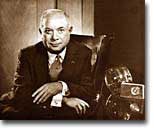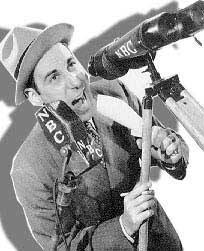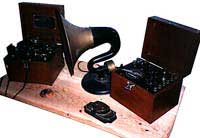46g. Radio Fever

Commercial radio in America had humble beginnings. Frank Conrad, an engineer for Westinghouse, set up an amateur radio station above his garage in a Pittsburgh suburb. Since the wireless technology was developed by Guglielmo Marconi in the late 19th century, thousands of enthusiasts across the world experimented with the new toy. After World War I, Conrad began broadcasting a variety of programming from his "station." High school music groups performed, phonograph records were played, and news and baseball scores were reported. Conrad had dramatically improved the transmitter, and soon hundreds of people in the Pittsburgh area were sending requests for air time. The bosses of Westinghouse knew that Conrad was on to something and convinced him to make his hobby commercially profitable.

Sports broadcasts helped boost the popularity of radio.
KDKA on the Air
On the night of November 2, 1920, Conrad and his Westinghouse associates announced that Warren G. Harding had defeated James Cox to become the next President. The message was heard as far north as New Hampshire and as far south as Louisiana. The federal government granted the call letters KDKA to the Pittsburgh station and a new industry was born. For nearly a year, KDKA monopolized the airwaves. But competition came fast and furious; by the end of 1922, there were over 500 such stations across the United States. The federal government excercised no regulation over the nascent enterprise, and the result was complete chaos. Stations fought over call letters and frequencies, each trying to outbroadcast the closest competitor. Finally in 1927, Congress created the Federal Radio Commission to restore order.
Ad Time

One of the great attractions to the radio listener was that once the cost of the original equipment was covered, radio was free. Stations made money by selling air time to advertisers. The possibility of reaching millions of listeners at once had advertising executives scrambling to take advantage. By the end of the decade advertisers paid over $10,000 for an hour of premium time.
The Radio Corporation of America created a new dimension to the venture in 1926. By licensing telephone lines, RCA created America's first radio network and called it the National Broadcasting Company. For the first time, citizens of California and New York could listen to the same programming simultaneously. Regional differences began to dissolve as the influence of network broadcasting ballooned. Americans listened to the same sporting events and took up the same fads. Baseball games and boxing matches could now reach those far away from the stadiums and arenas. A mass national entertainment culture was flowering.






